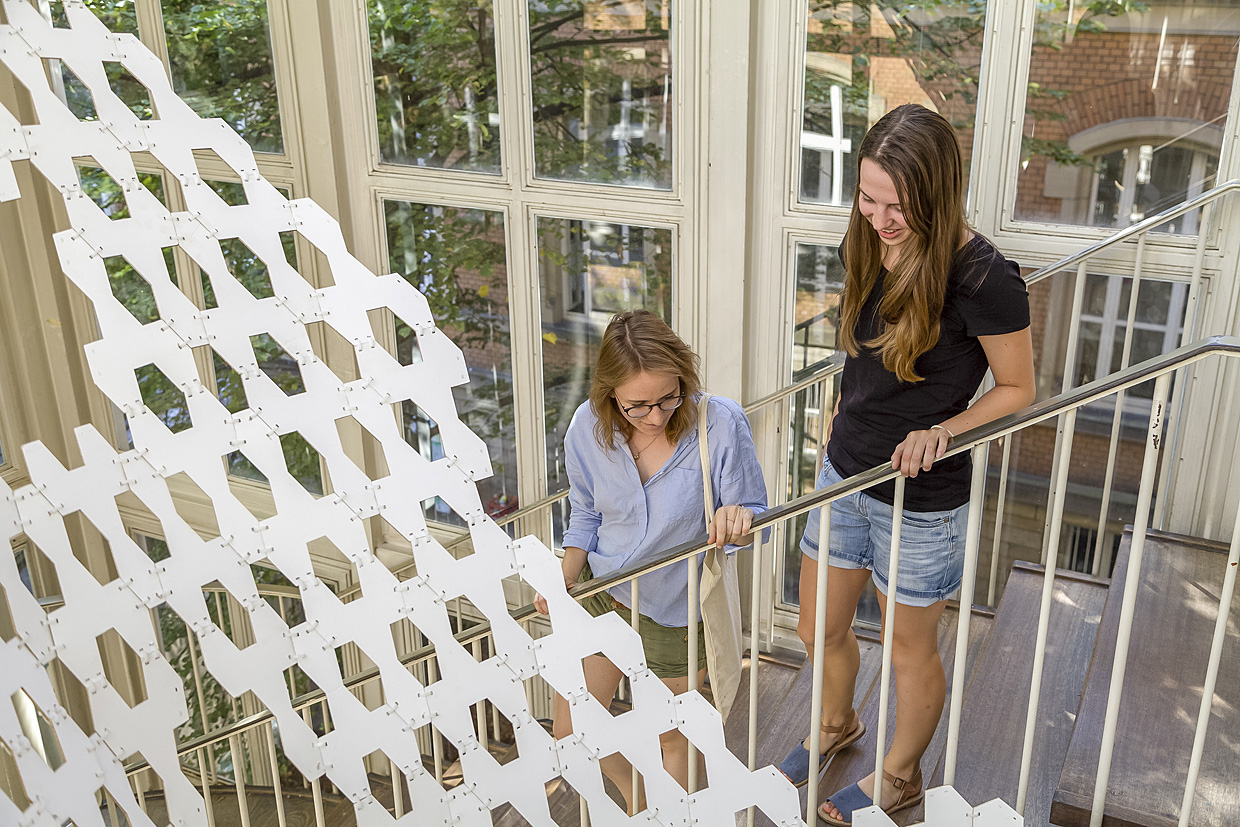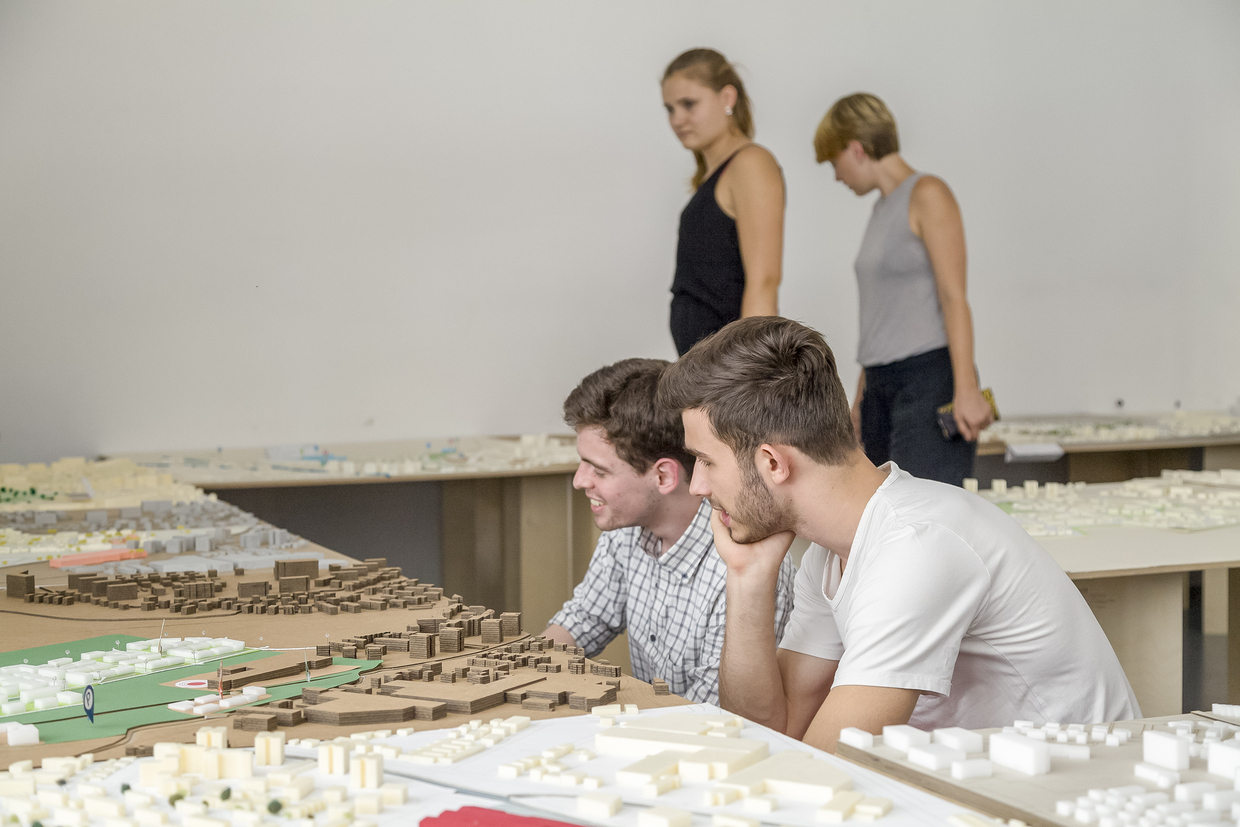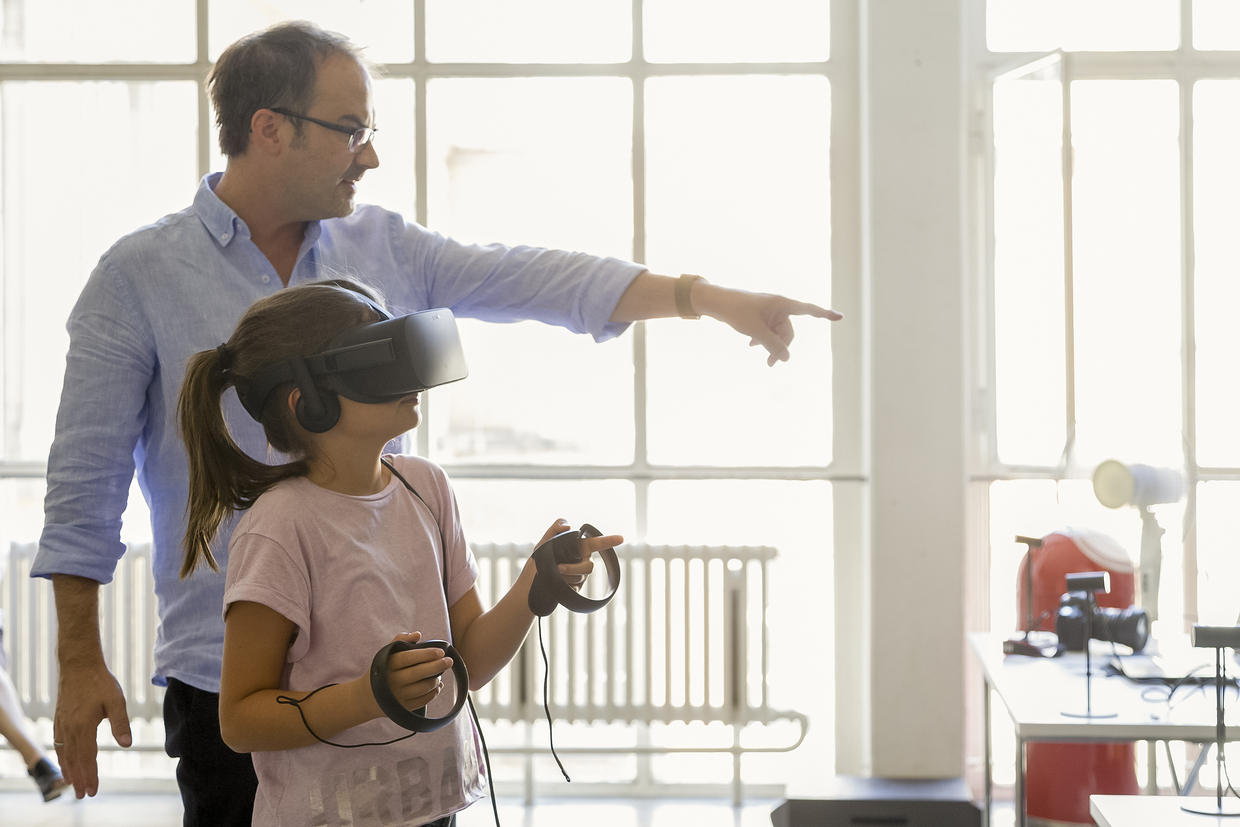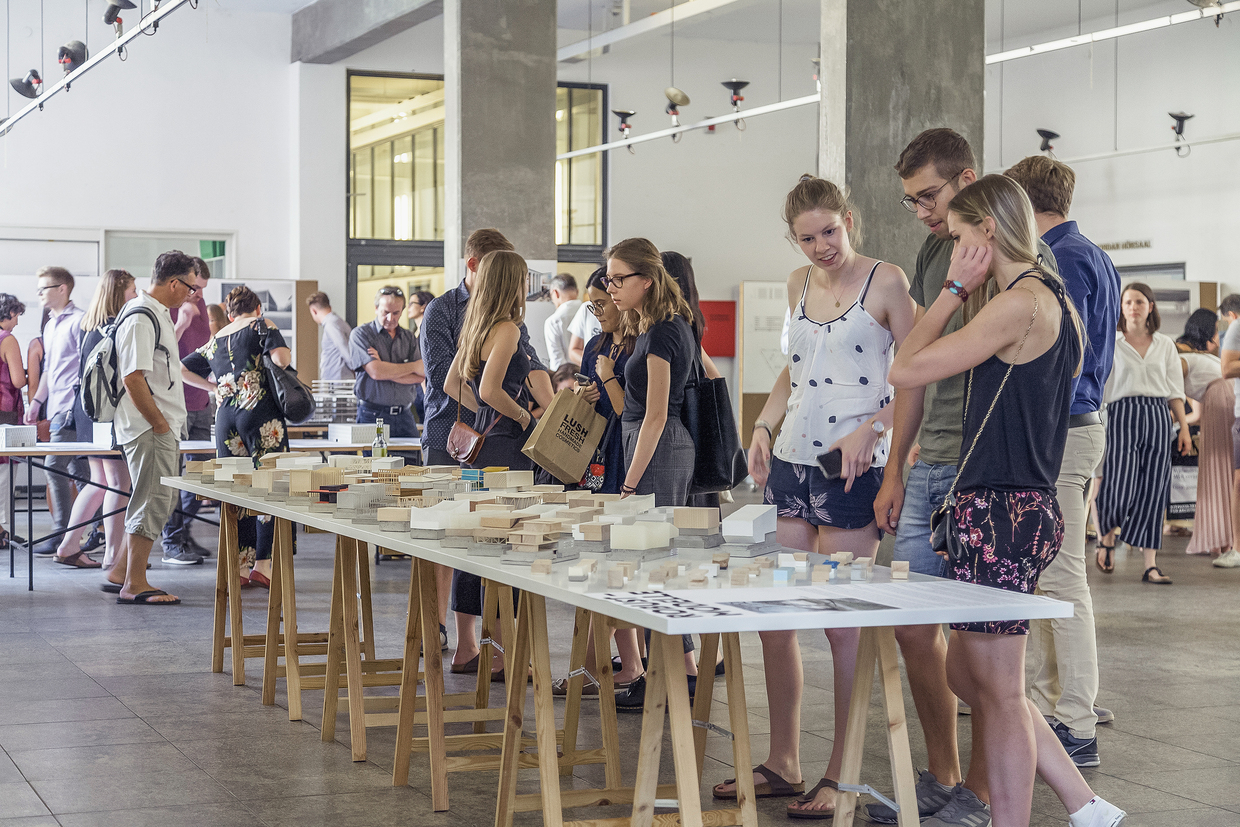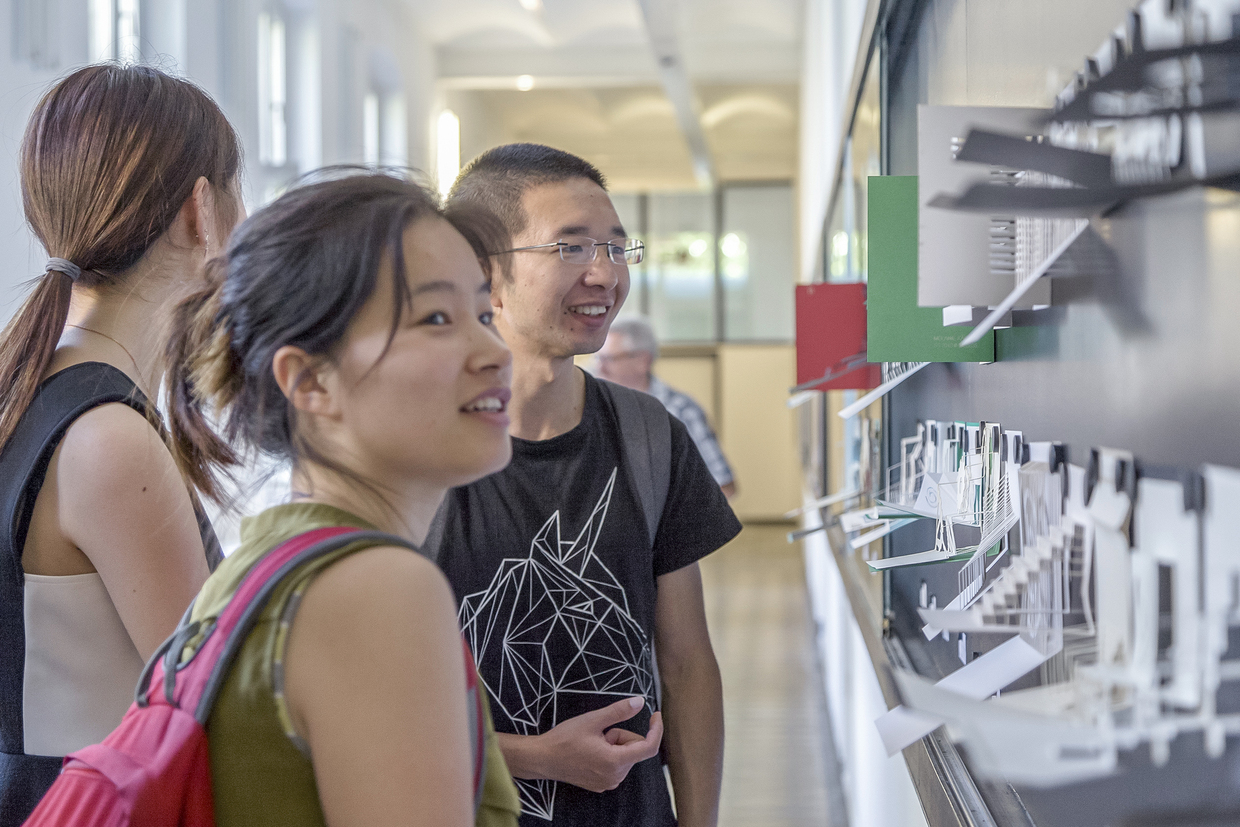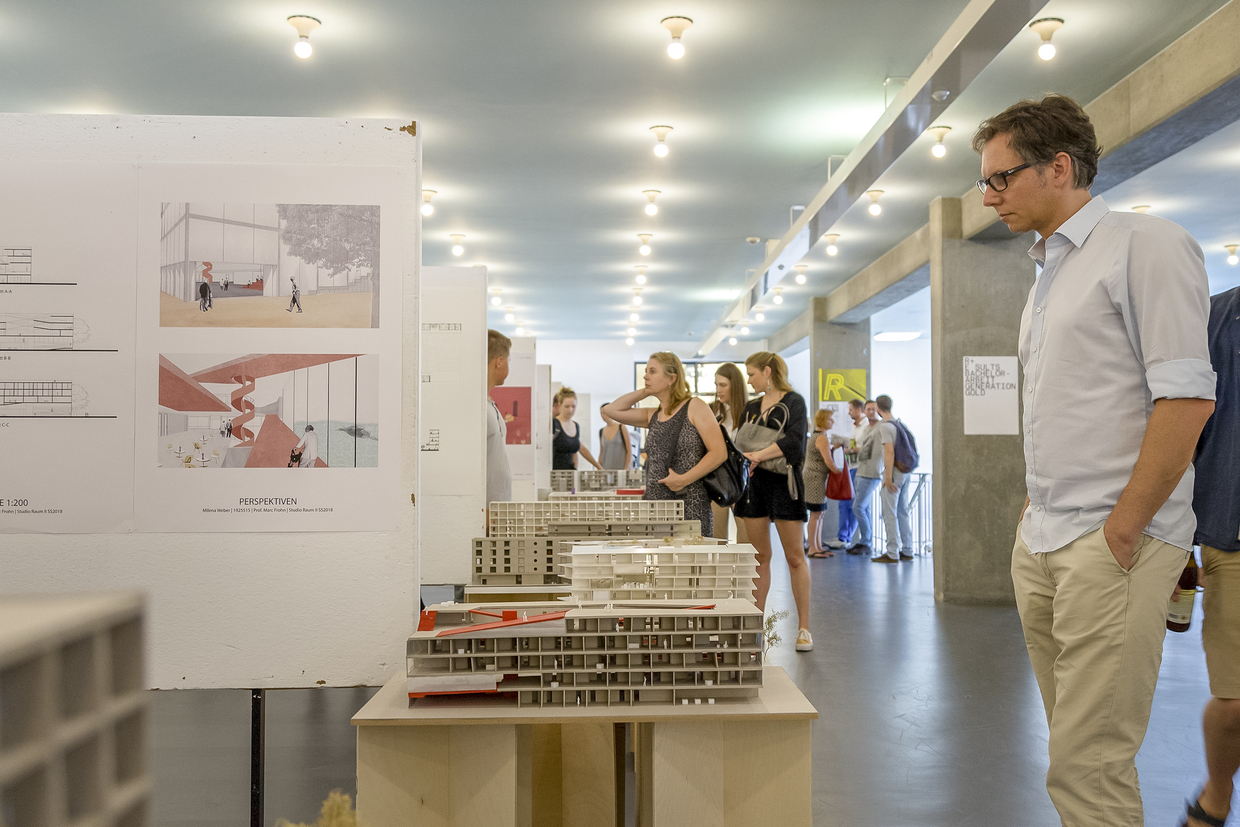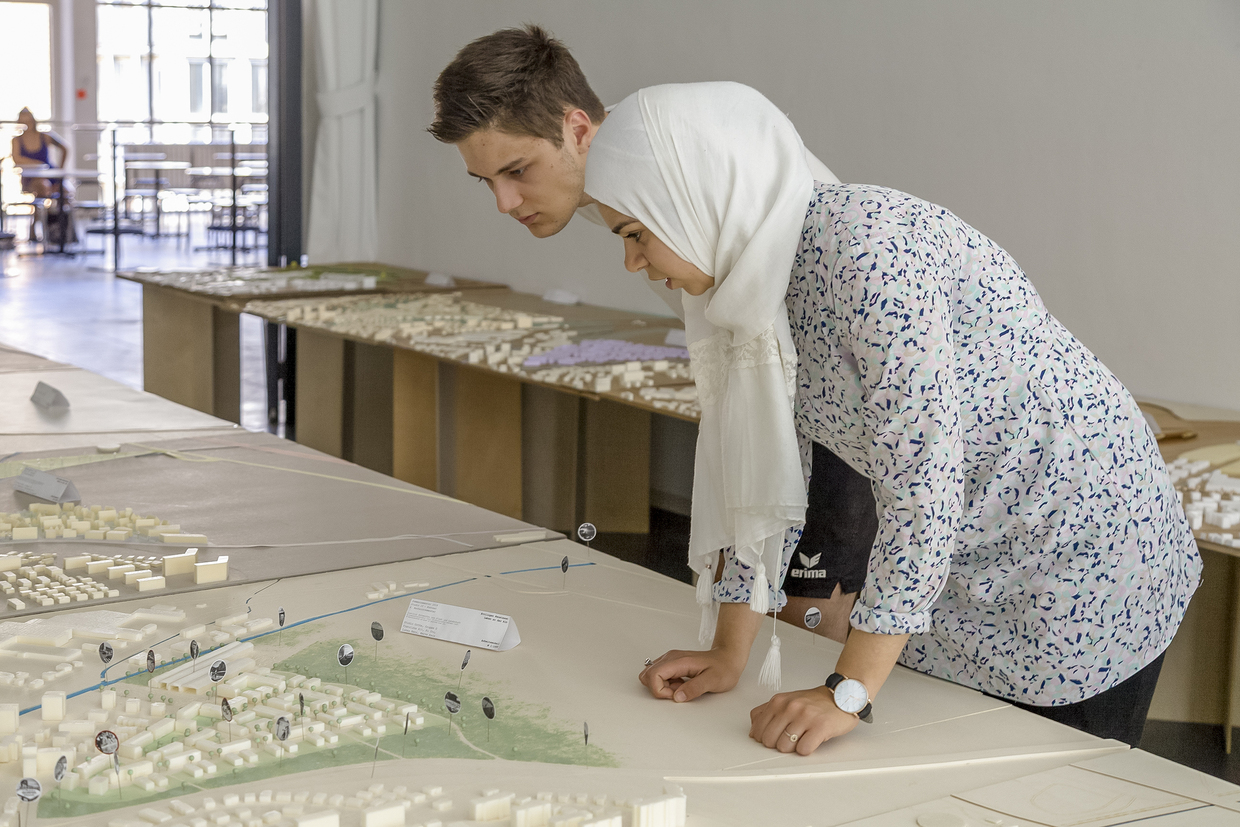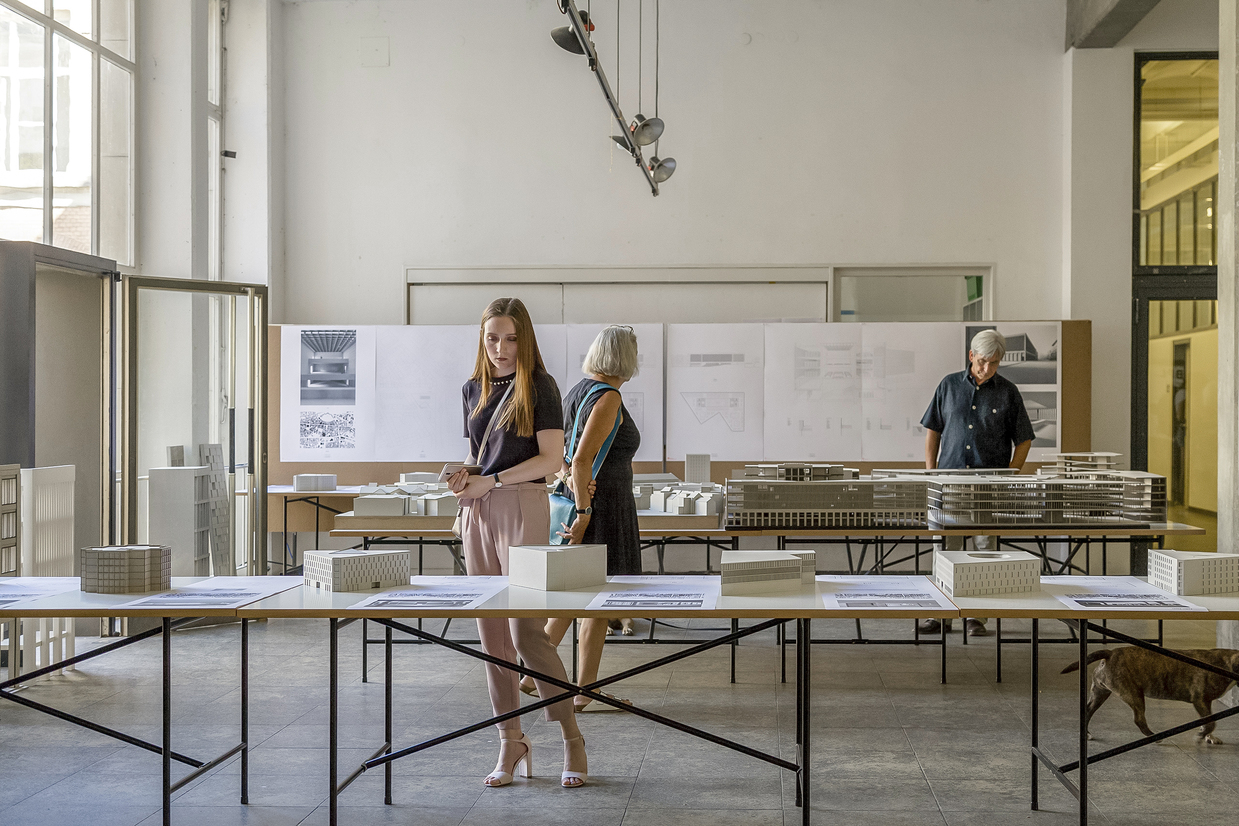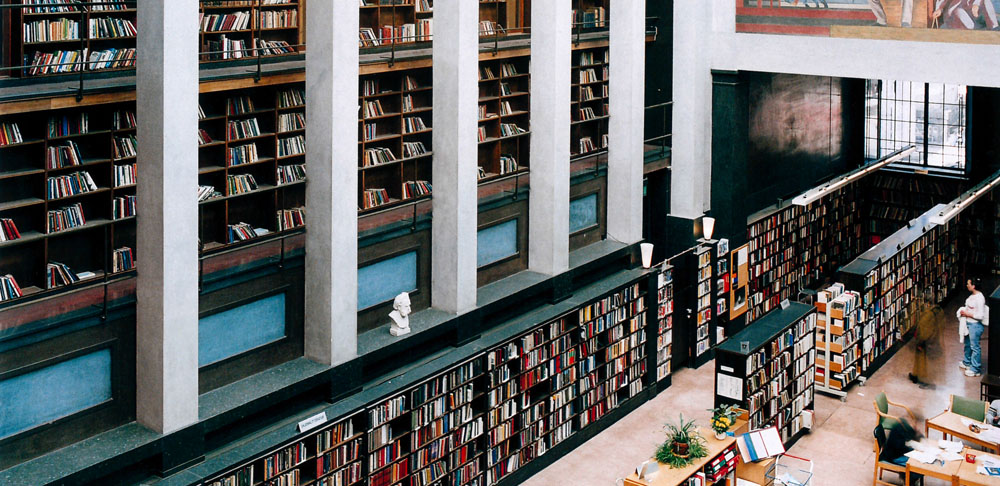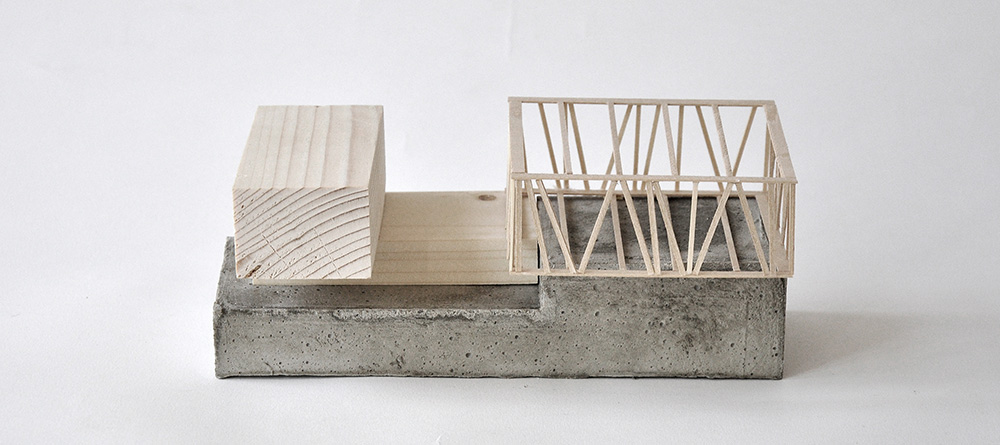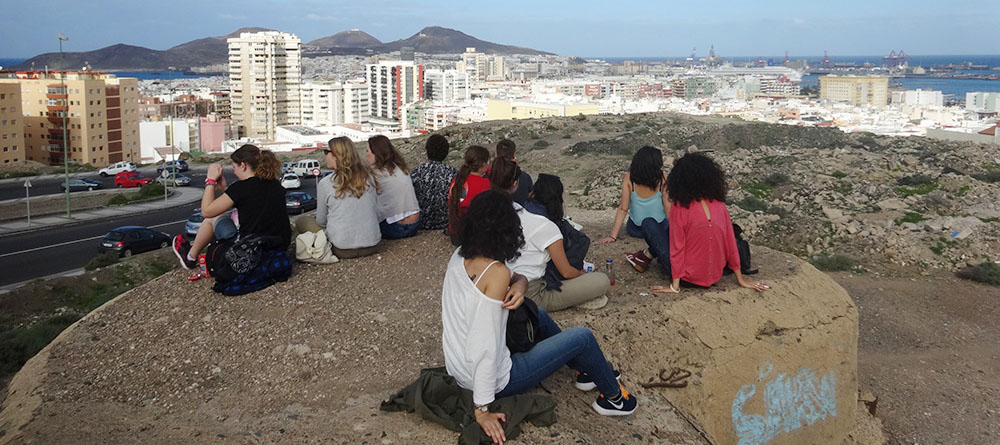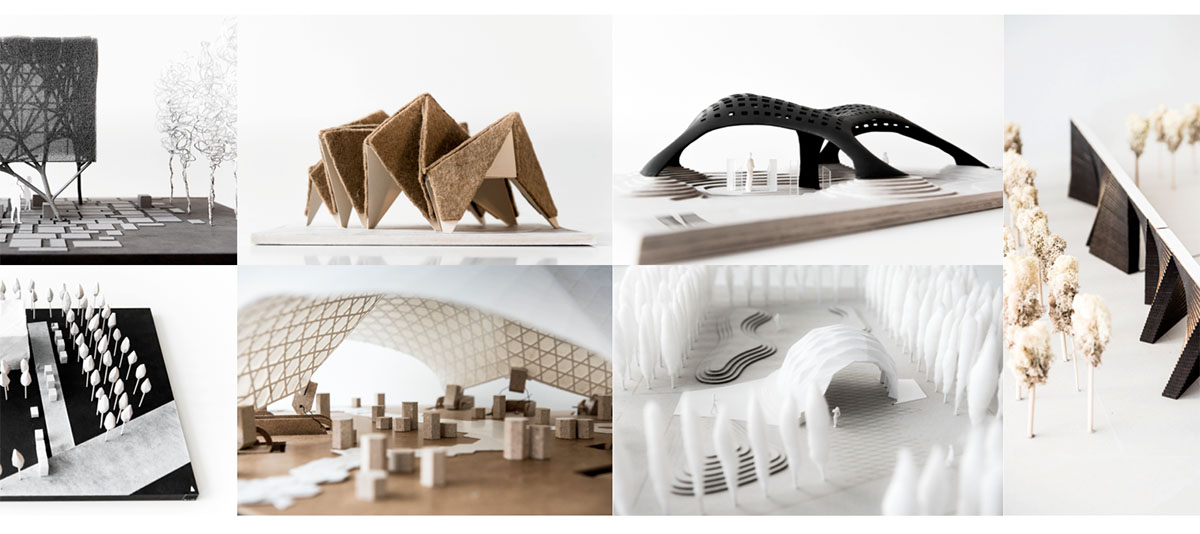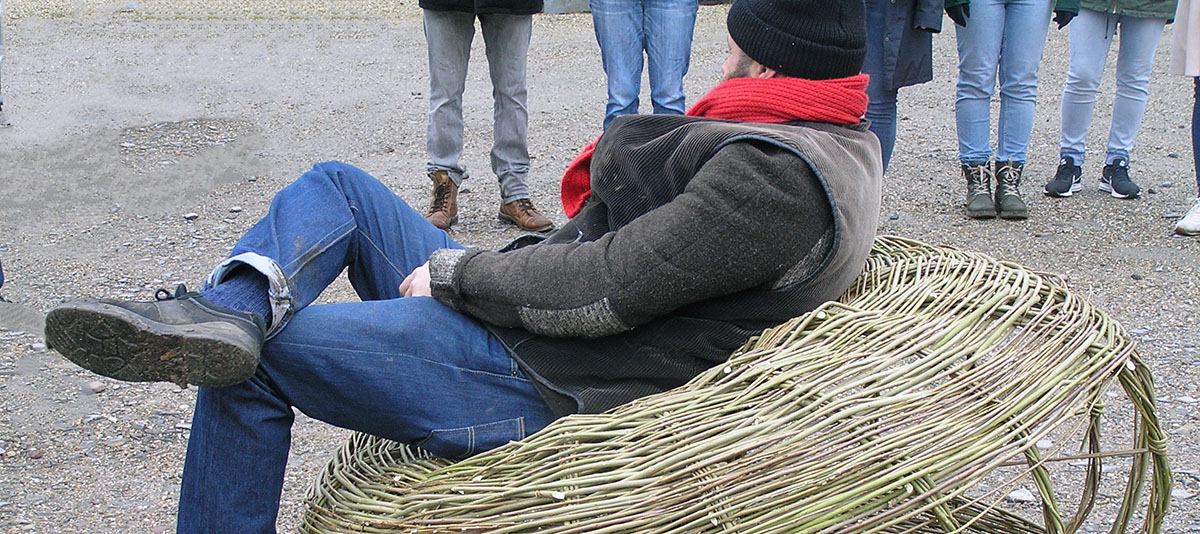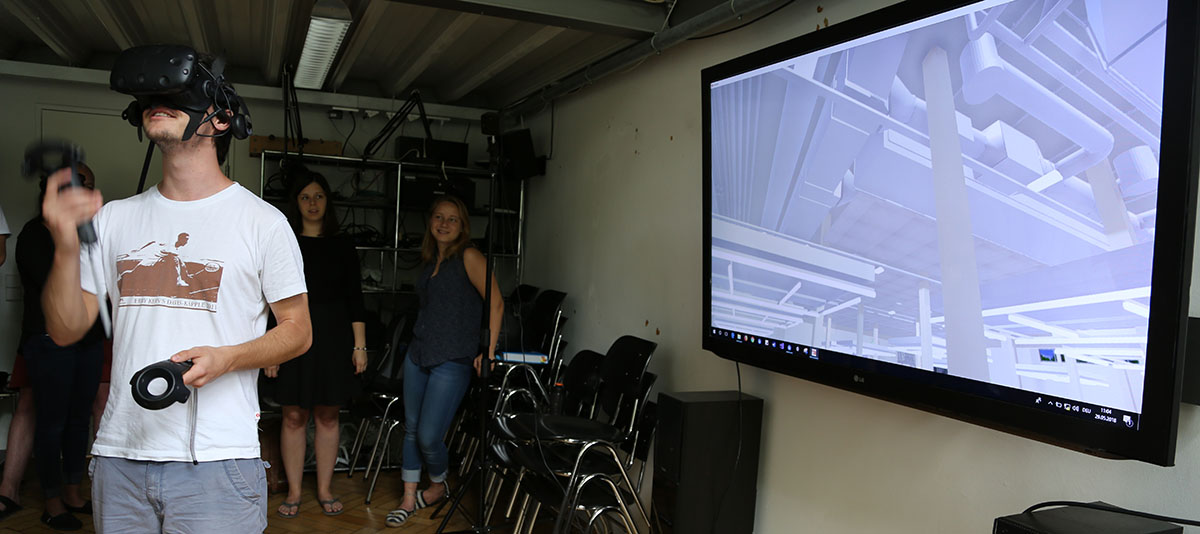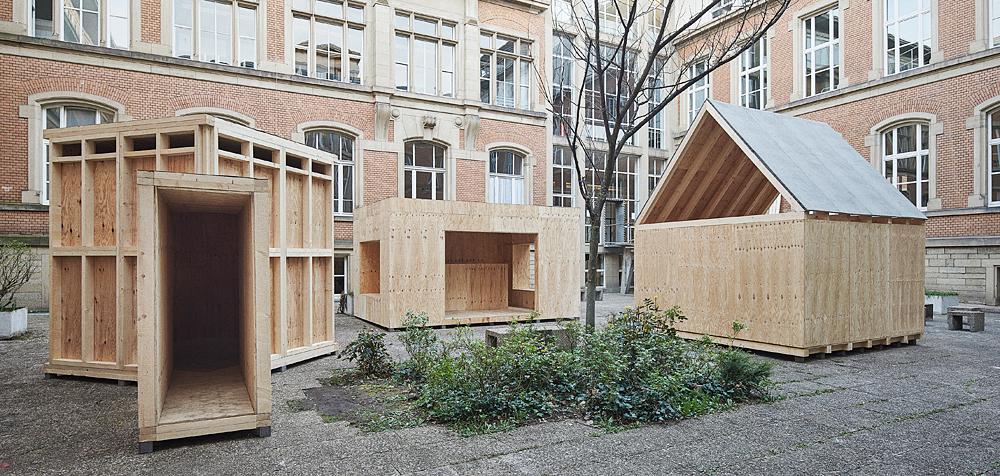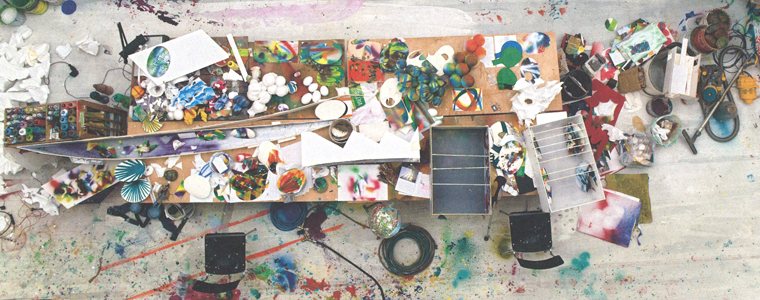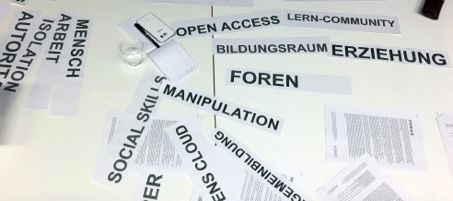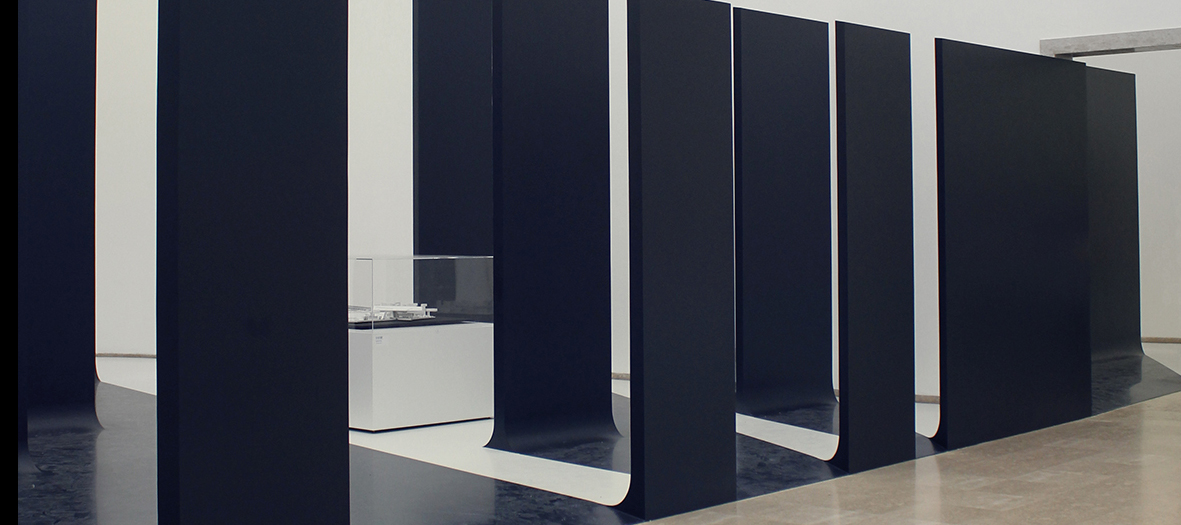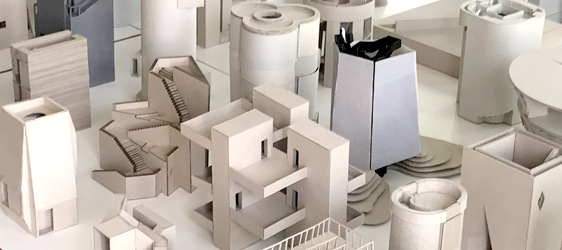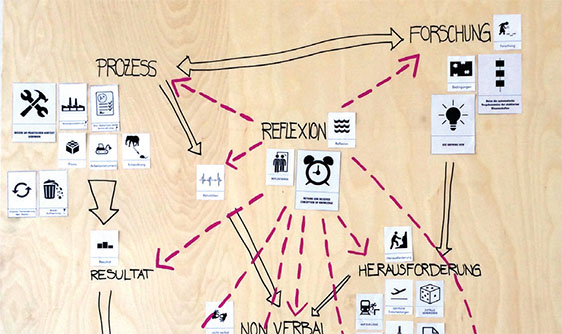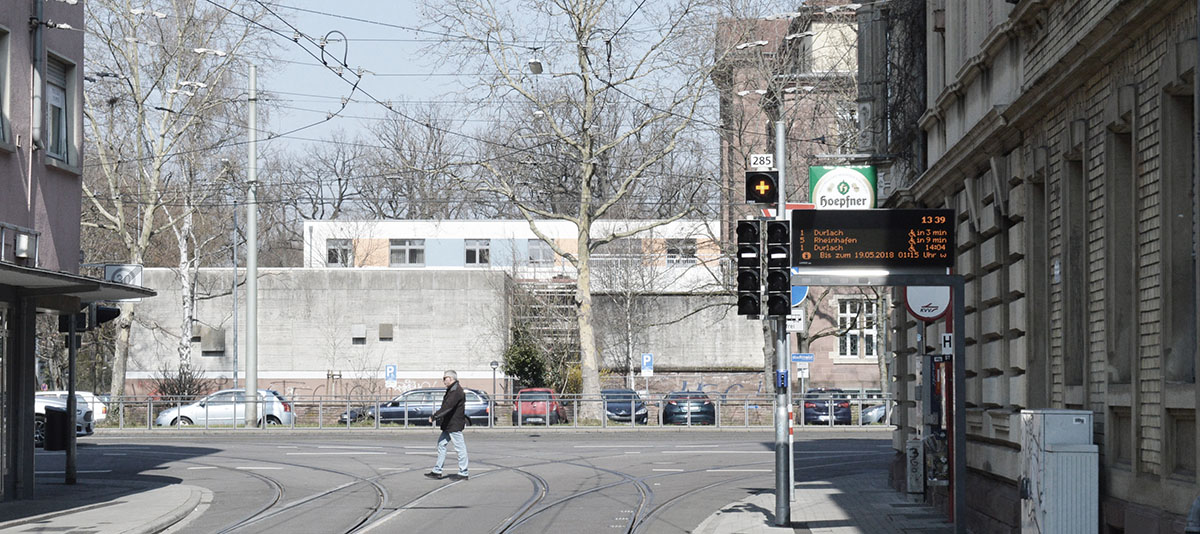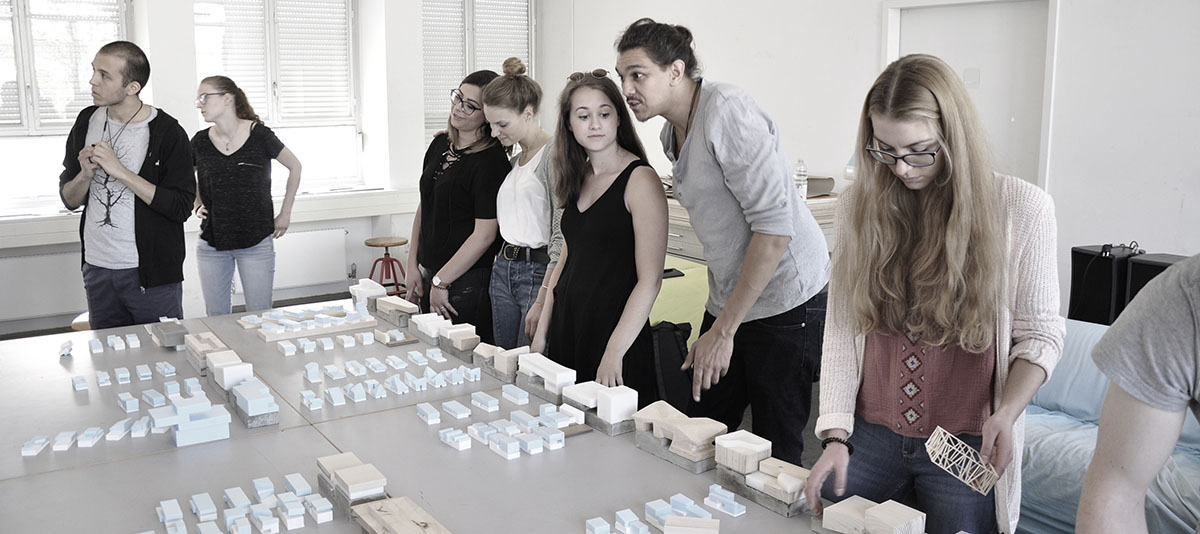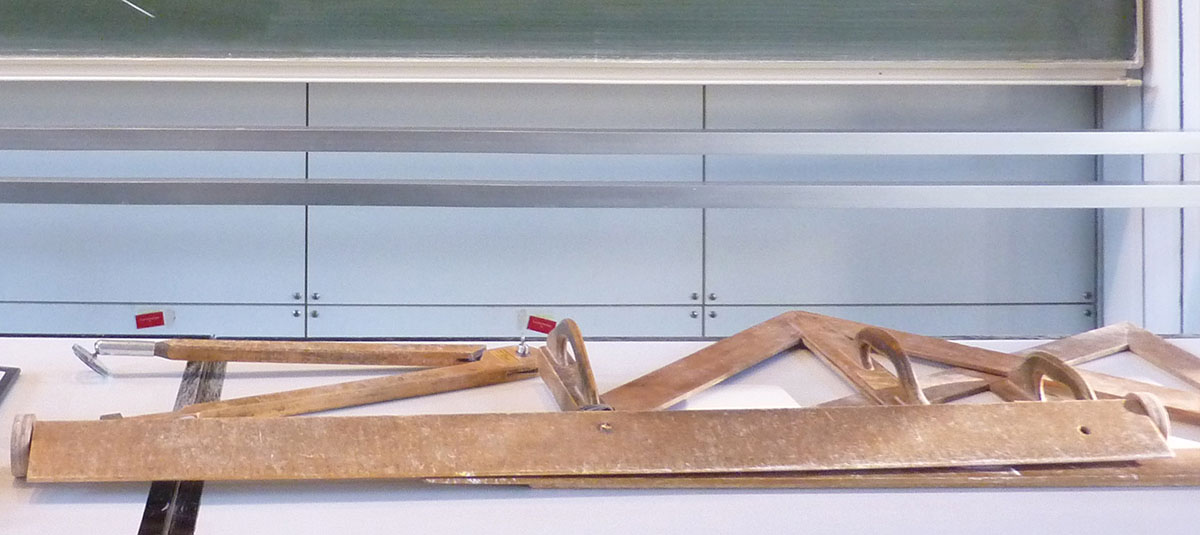Look inside 2018
Annual exhibition of the KIT Department of Architecture
Wednesday, July 18, 2018, from 4 to 9 p.m.
It's that time again! At the end of the summer semester, the Department of Architecture at the Karlsruhe Institute of Technology cordially invites you to its annual exhibition. On July 18, 2018, from 4 p.m. to 9 p.m., the departments, workshops, and studios will present works and projects from the past academic year and provide an insight into the range of teaching and research at the department.
The programme includes presentations, short lectures, guided tours, the farewell of the Bachelor graduates, the exhibition of the Bachelor theses, the awarding of the Heinrich Hübsch prizes and the presentation of the new yearbook of the department. You will find the exact programme here shortly.
It's worth taking a look!
Department of Architecture
Campus South / Building 20.40
Englerstrasse 7
76131 Karlsruhe
Programmübersicht (Stand: 28. Juni 2018)
sprungmarken_marker_3006
According to places
Ground floor:
Information stand of the department
Foyer
Here you can get
- the program of the annual exhibition
- Information material about studying at the department
- the yearbook 2018, hot off the press
This is also the starting point of the guided tour at 17:30 hrs.
Bachelor farewell
Farewell ceremony for Bachelor graduates and awarding of the Heinrich Hübsch Prize
Fritz-Haller lecture hall, 6:00 p.m. to approx. 7:30 p.m.
Presentation of the Bachelor theses
Department of Building Science
City Library in Karlsruhe
The bachelor thesis is dedicated to the type of library with the question, which role the library takes over for the city and the citizen in the 21st century. This is done in awareness of the fact that the type 'library' from today's point of view is perhaps no longer understood as contemporary, as a building for the collection of knowledge from analogue times. Nevertheless, the library can more than ever be a place for experiencing and sharing knowledge in the fabric of the city, sees itself as a continuation of the public space. This definition of a library is contrasted with the idea of the city.
Department of Building Planning
Robust
In their bachelor thesis, the students are asked to transform a former operations bunker in Karlsruhe into a house for music and movement. The focus of the design task is on the architectural object, i.e. on the examination of the design-generating structure, the architectural space and its materiality. As part of the in-depth study and as an integral part of the semester design, the focus was on design work with models. The analysis and reflection of the formal quality of the building cubature, the choice of model materials, and the representation of the interior concepts were of importance here. The aim of the course was to gain a deeper understanding of working with models as an active design tool and to extract and make visible implicit (design) knowledge.
Concept models for the bachelor thesis are presented.
Further parts of the bachelor thesis are exhibited in the corridor 2nd floor west.
Fabricated Topologies
Left inner courtyard and staircase north-west
The presentation shows the results of a seminar on computer-aided design with Christian Tschersich (LAVA, Stuttgart) at the Department of Building Lifecycle Management.
1ST FLOOR
Institute Design of City and Landscape:
Landscape Architecture, International Urban and Regional Planning and Building in Rural Areas.
Room 104 (Green Grotto) and Foyer
City and Landscape
In the exhibition of the Institute of Urban and Landscape Design the departments display different media about selected courses. Models, photos, books and discussions will be presented from the places that students, as well as teachers, have dealt with in the last semesters. The designs, workshops and seminars are presented in excerpts and in a process-like manner. In room 104 - the "Green Grotto" - a model landscape invites you: Wander through the currently processed designs of the 4th semester Bachelor students, through a design area on the northern edge of Ettlingen. The models show the interim status of the students' designs for a new residential area. In the foyer on the 1st floor, a large book table with various publications provides additional space for browsing and discussion. Slide shows show impressions of excursions and workshops of the departments, and give an insight into the multi-layered issues of contemporary urban and landscape planning at different ends of the world.
Lectures:
16:30 - 16:45 Green Grotto.
FG ISTB - Studio Context - Living on the Alb - 4th semester students present their current state of urban design on a model
17:00 - 17:15Green Grotto
FG RBL - Studio Kontext - Living on the Alb - Students of the 4th semester present their current state of the urban design on the model
17:30 - 17:45 Green Grotto
FG LA - Studio Kontext - Living on the Alb - Students of the 4th semester present their current state of the urban design on the model
Departments Building Lifecycle Management and Urban Neighbourhood Planning
Foyer 1st floor (in front of the Green Grotto)
16:00 - 20:00
Virtual and Augmented Reality in Architecture and Urban Design
How can architects in the future use simple means and a consistent workflow to check their models in the design or make the result tangible to the layman? This question was addressed in an interdisciplinary seminar by students and researchers from the fields of Building Lifecycle Management (BLM) and Urban Neighborhood Planning (STQP) in the summer of 2018. In this seminar, Ivonne Zelling, Volker Koch and Peter Zeile tested for the first time how future architects and urban planners can integrate these new immersive technologies and methods into their working environment. Individual results will be presented at the exhibition from 4 to 8 pm. You are cordially invited to get your own impression of the digital worlds. Be curious and immerse yourself in virtual reality.
Sustainable building
Room 141.1 (Materials Library)
Building from Waste
In the light of dramatically diminishing natural resources, it is no longer a question of improving the status quo; rather, it is a question of a paradigm shift in the building industry in order to be able to satisfy the future demand for building materials at all. Using models, drawings and material samples, the Department of Sustainable Construction presents a selection of student work on the topic of "Building from Waste - a pavilion for the Federal Garden Show 2019". The designs created in the winter semester 2017/18 stand for an innovative and sensible use of existing and recycled resources.
Study workshops
Room 136
The study workshops wood, model, metal, photography and digital present exemplary projects.
Department of Building Technology
Room 132 and corridor
Impromptu weaving
The results of the impromptu weaving project with the theme "One summer long" will be exhibited. The students had the task to design, build and test the functionality of a seating furniture made of self-cut willow.
R&D-Project "Novel Oil Conduit and Oil Absorption Systems for Coastal and Inland Waters
For the absorption of oil in case of accidents on inland waters, an oil conduit and oil absorption system was developed, which uses the principle of "cross flow" for feeding rays. The principle could be implemented and tested in a textile structure and is demonstrated on a small water channel.
R&D project "TransMembrane - Development of transparent textile structures for membrane systems
The company Ettlin has developed a fabric which is permeable to air and at the same time offers protection against rain. The difficulty in using this fabric in textile architecture lies in the special ratios of strength and stiffness in warp and weft directions. A small demonstration sample can be used to show the shaping, waterproofing and air permeability.
Subject area load-bearing structures
Room 130
16 to 20 o'clock
Cross-section of teaching and research
On the basis of selected student works the teaching spectrum of the department is presented. Particularly successful models and sketchbooks will be exhibited. In addition, a slide show will be shown that provides a cross-section of the teaching programme of the Bachelor's and Master's degree courses. An insight into the research activities of the department will be given in the form of exemplary project posters.
Master's course in the restoration of old buildings
Room 130 and showcase in the corridor
16 to 20 o'clock
Cross-section of subjects: Dealing with the existing building stock and the existing building stock as a resource
The task was, on the one hand, the Guest Lecturer House from 1966 on the South Campus of KIT, which was built for guest scientists and guests of KIT. It has 45 guest rooms and a restaurant area and is now to be revitalized and converted into a conference center. Secondly, the so-called Gärtnerhaus (gardener's house) on Heidelberg Castle, the foundation walls of which date back to the 17th century, which is currently empty and for which a use appropriate to the house, but also a representative prelude to the castle tour, should be found.
Building Lifecycle Management (BLM)
Room 118
17:00 and 19:00
BLM.Prozesse - Presentation of student work
The department presents results of the FALT.process from the stegreifen "Karlsruher PopUpModel" and "PopUpCard". The applied paper-cutting art "Kirigami" is reminiscent of the widespread folding technique "Origami" and creates objects with different light and shadow reflections.
In addition, works of various ENTWURFS.processes of the studio design "Tiny Houses" as well as the master design "HOCHBunker Dammerstock" will be exhibited. Master students report on their experience in the PLANNING process of the current BIM design "How do you want to live?" and provide insight into the interdisciplinary project work with the Department of Civil Engineering.
Department of Building Science
Corridor in front of rooms 108 to 116
Hybrid types
Two master's designs from the department's long-term study of "hybrid types" will be presented: a townhouse in Milan and a hotel and bus terminal in Zurich. The examination takes place on the one hand in the historical context of the cities and on the other hand in full awareness of how diffuse both typologies are from today's point of view.
Architecture in India / Excursion to India
Starting from the epochal masterpieces of Louis I. Kahn and Le Corbusier, the excursion took a look at the architecture of India in the pre- and post-colonial period. How did India's traditional, rich culture and architecture influence these two Western architects in their work, and what do these projects in turn mean for India's more recent architecture?
Studio Space "The Architectural Elements / The Architectural Space ".
The basic teaching in the 1st semester of the Bachelor can be summarized under the two headings "The Elements of Architecture" and "The Architectural Space". The tasks lead in the form of analogue drawings and models on a scale of 1:200 to 1:20 up to the built reality on a scale of 1:1.
Teaching area architecture and furniture
Room 108 and the corridor in front ofit
Design+
The department presents bar designs, furniture, posters and a film.
Architecture Library
Room 106
B³ Books and punch in the library
The subject library architecture offers from 16.00 o'clock on:Book flea market and summer punch (also without alcohol).
If required and in demand, the staff will give guided tours of all floors, including the Werner Sewing Library, at 6:00 pm.
2ND FLOOR
Presentation of the bachelor theses
Department of Space and Design, Department of Building Planning, Department of Building Construction
In the foyer and in the corridors of the 2nd floor
Department of Space and Design
Generation Gold
Studio Raum deals with institutional spaces. How do these embody social rituals and rules and how are the latter formalised with their help? In the current semester, the students are dealing with the interface between institution and home.
The aging baby boomer generation is becoming the "Generation Gold". Their self-image is characterized by maximum self-determination and social participation. The familiar institutions of the old people's home, the nursing home and the hospice will have to adapt. Based on the ancient concept of "hospitium" (hospitality, hostel), the students develop new conceptual, programmatic and spatial approaches for the institutionalized overlapping of service and living of the "Generation Gold": Through what does the institution become a host? What is hospitality in the age of care robots? How does the home become a home?
Subject area building construction
Maison d'Artiste
The Maison d'Artiste is a production and exhibition space for artists and cultural workers. It compensates for the gap in open spaces which are increasingly being pushed out of the city by gentrification. With its heterogeneous program it offers an open space for different forms of work. In addition to the studio space, an artist-in-residence program and a café will be established. The intention is to create a building that on the one hand ties in with the tradition of the location and at the same time redefines the typology of the studio.
Department of Architectural Theory
Room 258
The long summer of theory
Whether architecture and the atom, Datatopia or the university as political space: what drives us in an increasingly complex, on the one hand coded but at the same time deciphered present, is the search for questions and the discussion of topics on possible futures in society and architecture. What potential does theory and critical thinking hold in this context?
Another long summer of theory announces itself, to which we invite you with espresso and good conversations...
The AT-Espressobar is open from 16h.
Department of Architectural Communication
Room 257/259
You've got to get in to get out: three times a*komm
The exhibition provides insight into the diversity of architectural communication topics. On display are the results of the research seminar "The bricks that built the houses", in which we empirically and psychologically investigated the perception and evaluation of innovative building materials. The project seminar "Picture this" dealt with the use of photography as an instrument in the design process. The video "freespace" shows excerpts from an ongoing research project that documents and analyzes current developments in the exhibition of architecture based on the Venice Architecture Biennale.
DesignConstruct :
Department of Building Construction, Department of Fundamentals of Building Construction and Department of Constructive Design Methodology
rooms 240, 241, 242 andterrace
work in progress
EntwerfenKonstruieren presents student work from the current bachelor and master courses with plans, models, films and publications produced at the department. If you are particularly interested, a short tour of the department is possible. In good weather, our terrace invites you to exchange ideas and have discussions.
Department of Building Physics & Technical Construction
Room 235
17 to 18 o'clock
The fbta focuses on the topics of energy efficiency and comfort in buildings. Various simulation tools are used to analyse the performance of buildings in the planning phase, while measurement technology and the statements of users help to assess whether the planning objectives have been achieved during building operation. This spectrum is to be demonstrated to visitors to the exhibition by means of a number of examples - particularly from the point of view of how and which tools can already be used for design evaluation during architectural studies.
Building simulation
Simulations are used to represent a room situation and evaluate it in terms of lighting technology and energy. Different influencing variables (e.g. window size, glazing quality, shading elements) can be varied.
Solar potential of quarters
With a 3D CAD project editor, groups of houses can be modelled to scale and examined for their solar potential. Sunshine hours or solar irradiation on horizontal and inclined surfaces can be calculated and displayed using false colors.
Thermal comfort at the workplace
With the help of CFD simulations, workplace situations are evaluated with regard to thermal comfort. In particular, the influence of air flows caused by fans in the vicinity of people is to be demonstrated.
Thermal comfort is influenced by different indoor climate parameters. Visitors will have the opportunity to test the effect of different influencing variables (air movement, radiant heat) at a workstation and evaluate them themselves. This can also be compared with the simulations above.
Department of Fine Arts
Room 204 (Drawingroom )
Artistic works by students of the Department ofFine Arts
The artistic works from the bachelor and master seminars "Übung Zeichnen+", "Das Objekt", "How to make a book", "Aktzeichnen", as well as "Navigator" and "Slack_Space" will be presented in the form of sketchbooks, objects, book objects, drawings and photographic documentations.
arch.lab
Room 204 (drawingroom )
16 to 21 h
Research fields
In the summer semester 2018, five seminar formats from very different subject areas of the department are represented in the arch.lab - all of them addressing the question of how one can "learn to research" within architectural education - and which approaches and methods play a role in this. On display will be concepts and results of student research on the following questions:
How does art research in space? (Fanny Kranz / FG Visual Arts)
How does one develop a material? (Sandra Böhm / FG Sustainable Building)
Can "nature" be coded? (Susanne Gerstberger / FG Landscape Architecture and Design)
How did designing, drawing and measuring work in the early Middle Ages? (Katharina Peisker / Architectural History Group)
Where does comfort end in summer? (Dr.-Ing. Cornelia Moosmann, Dr. Marcel Schweiker)
Department of Building Planning
Corridor 2nd floor west
ROBUST - Sculpture
In their bachelor's thesis, the students are asked to transform a former operations bunker in Karlsruhe into a house for music and movement. The focus of the design task is on the architectural object, i.e. on the examination of the design-generating structure, the architectural space and its materiality. In the design process, the concept of robustness is to be questioned and evaluated: What potential does the existing architectural sculpture have and how can this be transformed into new spatial qualities. The resulting designs will be presented on the basis of plans and models.
ROBUST - Studio
A series of pictures gives an insight into the different events of the design teaching in the bachelor and master course of the current semester at the department of building planning: Among other things, impressions of the work in the studio, the work on models and the excursion to Berlin are shown, which was nevertheless in the context of the concept of Robust and Building in Existing Contexts.
Department Space + Design
Rooms 218 and 219
The Department of Space + Design is showing an overview of the work of the past year. Drawings, models and projections are presented in two rooms.
Department of Descriptive Geometry
Room 211
Architectural Geometry and Digital Design
In the first three semesters of the bachelor's programme, this course provides a basic understanding of geometric and design principles and promotes the sharpening of spatial imagination. Skills in the use of both manual and digital tools are developed.
On display are outstanding examples of the final projects of the respective semesters: hand-drawn axonometries, computer-generated renderings and handcrafted digitally designed portfolios.
Right courtyard
Architecture bar of the architecture student body
Drinks and food
Satellite
DON'T call it research
An exhibition on the topic of artistic research
16:00 - 21:00
Kaiserstraße 99, Karlsruhe (5 minutes walk from the department)
Five students present their results from the research seminar "NO_FAQ. Artistic Research as Input for Architecture" in the form of drawings, photographs, videos, objects and notes in the currently vacant shop unit of Kaiserstraße 99.
"What is missing?" - master's students dealt with this initial question as part of the research seminar at the Department of Visual Arts. They were asked to analyze visible and invisible spatial structures of institutions using the example of the Badischer Kunstverein. The missing, invisible knowledge was to become the essential object of research. Based on the thesis that artistic practice generates knowledge per se, processes based on artistic procedures were initiated by means of micro-studies.
The exhibition will open on 18 July 2018, 16:00 - 21:00.
It can be visited with free admission until 22 July
(July 19 - July 21 10:00 am - 2:00 pm, July 22 4:00 pm - 7:00 pm).
The exhibition is supported by Karlsruher Fächer GmbH.

